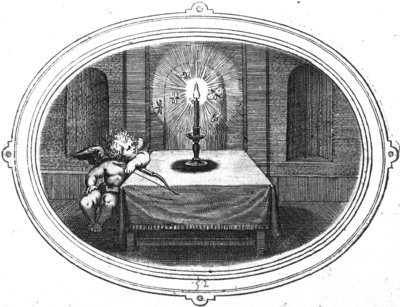Brevis et damnosa voluptas [52]

Translations
 |
Een kort en pijnlijk genoegen. |
 |
A short and hurtful pleasure. |
Literature
- Henkel and Schöne, Emblemata
 , col. 911
, col. 911
- Moseley, Century of Emblems
 , p. 134
, p. 134
- Praz, Seventeenth-Century Imagery
 , p. 113
, p. 113
- Discussion of Lohenstein's use of this emblem in
Sophonisbe: Schöne, Emblematik und Drama
 , p. 106
, p. 106
- Sebastiàn, Lectura crítica
 , p. 30
, p. 30
Sources and parallels
- Brevis & damnosa voluptas [33] (in: Otto Vaenius, Emblemata aliquot selectiora amatoria (1618))
[Compare
![Compare [compare]](/static/images/compare2.gif) ]
]
- Junius, Emblemata [web]
 , embl. 49
, embl. 49 -
Parallel (and probably source) for the subscriptio and probably entire emblem: Cosi de ben amar porto tormento [8] (in: Daniël Heinsius, Quaeris quid sit Amor (c. 1601))
[Compare
![Compare [compare]](/static/images/compare2.gif) ]
]
-
Parallel for the pictura (mosquitos are attracted by a candle) and the meaning of the subscriptio: Cosi de ben amar porto tormento. [32] (in: Daniël Heinsius, Ambacht van Cupido, from: Nederduytsche poemata (1616))
[Compare
![Compare [compare]](/static/images/compare2.gif) ]
]
-
Parallel (and probably source) for the Latin subscriptio and entire emblem: Cosi de ben amar porto tormento [8] (in: Daniël Heinsius, Emblemata amatoria (1607/8))
[Compare
![Compare [compare]](/static/images/compare2.gif) ]
]
References, across this site, to this page:
- Cosi de ben amar porto tormento [8] (in: Daniël Heinsius, Quaeris quid sit Amor (c. 1601))
- Cosi de ben amar porto tormento [8] (in: Daniël Heinsius, Emblemata amatoria (1607/8))
- Cosi de ben amar porto tormento. [32] (in: Daniël Heinsius, Ambacht van Cupido (1613))
- Cosi de ben amar porto tormento. [32] (in: Daniël Heinsius, Ambacht van Cupido, from: Nederduytsche poemata (1616))
- Brevis & damnosa voluptas [33] (in: Otto Vaenius, Emblemata aliquot selectiora amatoria (1618))
Iconclass
A cupid contemplating the moths that fly into the flame of a candle- insects: butterfly
[25F711(BUTTERFLY)(++1)]

- insects: butterfly (+ dying animal; death of animal; dead animal)
[25F711(BUTTERFLY)(+63)]

- insects: moth (+ animals used symbolically)
[25F711(MOTH)(+1)]

- insects: moth (+ dying animal; death of animal; dead animal)
[25F711(MOTH)(+63)]

- sitting on an elevation
[31A2352]

- interior of the house
[41A2]

- table
[41A711]

- cover for table, etc.
[41A713]

- candle (+ kindling a light; lit, burning light, lamp, candle)
[41B31(+1)]

- candlestick
[41B313]

- archer's weapons: bow
[45C15(BOW)]

- Short Felicity; 'Felicité breve' (Ripa) (+ emblematical representation of concept)
[56B22(+4)]

- Pain, Sorrow, Sadness; 'Dolore', 'Dolore di Zeusi' (Ripa) (+ emblematical representation of concept)
[56BB1(+4)]

- Desire; 'Desiderio' (Ripa) (+ emblematical representation of concept)
[56F1(+4)]

- proverbs, sayings, etc. (with TEXT)
[86(BREVIS ET DAMNOSA VOLUPTAS)]

- non-aggressive, friendly or neutral activities and relationships of Cupid
[92D15]

- attributes of Cupid (with NAME)
[92D18(BOW)]

![[H O M E : Emblem Project Utrecht]](/static/images/rd-small.gif)


















































































































































